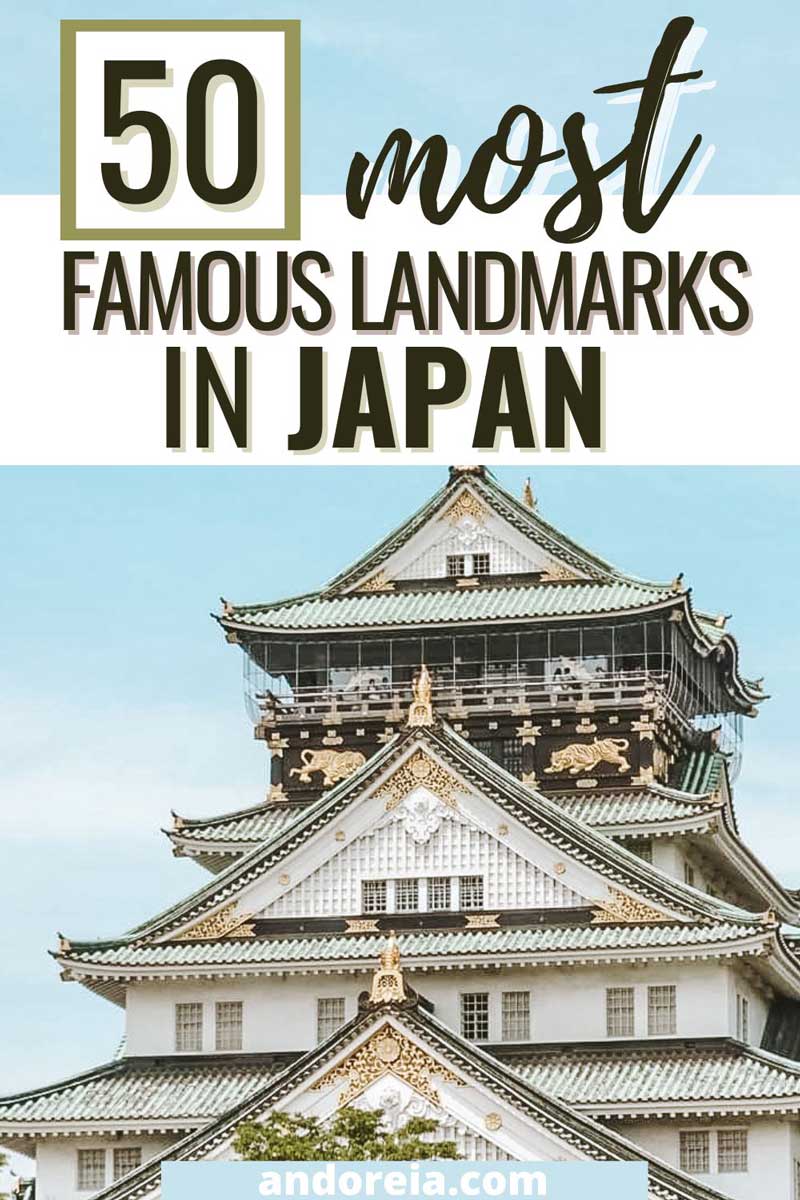When it comes to visiting spectacular or historically important landmarks, Japan is hard to beat. This comprehensive list includes some of the country’s most renowned attractions from the postcard-perfect Mount Fuji to Kyoto’s ancient temples.
So whether you’re planning a trip to Japan for the first time or you’re simply interested in learning more about its iconic landmarks, read on for details on 50 of the most famous spots in the country!
Disclosure: Some of the links in this post are affiliate links. If you click on them and make a purchase, I may receive a commission at no extra cost to you. Check my full disclaimer here.
Landmarks in Tokyo
01. Shibuya crossing
Shibuya crossing in Tokyo is arguably the busiest (and at the same time the most famous!) pedestrian crossing in the world. Located in the vibrant ward with the same name, there can be up to 3,000 people walking in all directions once the lights go green.
The scramble is fascinating to see and you can do this from the nearby Starbucks, which is a popular spot to observe the crossing or better yet, by actually taking part in it. During my visits to Tokyo, I must have crossed over 20 times.
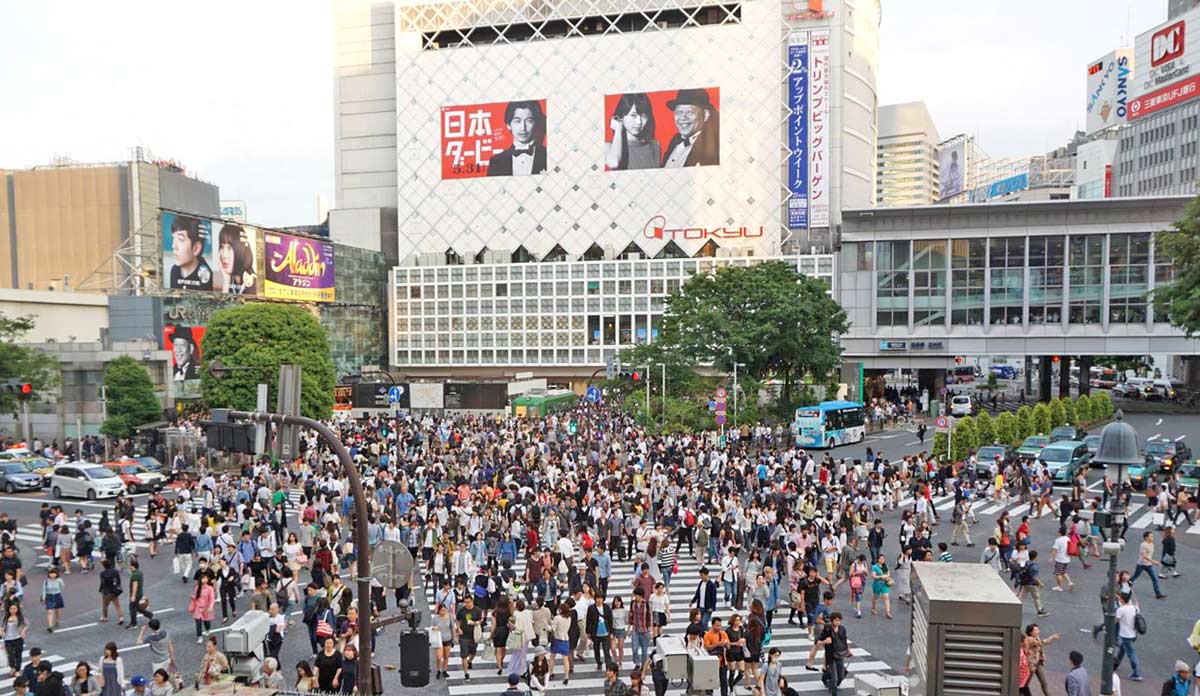
02. Tokyo Metropolitan Building
Located in Shinjuku, Tokyo Metropolitan Building (commonly referred to as Tochō) is the seat of the Tokyo Metropolitan Government which is in charge of the capital’s Metropolitan area. But that’s not the reason why I recommend you visit it.
The building is a huge skyscraper and has two FREE observatory desks at its top from where you can admire Tokyo’s panorama.
03. Tokyo Skytree
Completed in 2012, Tokyo Skytree is at the moment the tallest tower in the world with a total height of 634 m (2,080 ft). The broadcasting tower is also the 3rd tallest structure in the world, after the famous Burj Kalifa in Dubai and Merdeka 118 in Kuala Lumpur.
There are two observatories inside the Tokyo Skytree that you can visit, one at 350 m (1,150 ft), and the other at 450 m (1,480 ft). You can buy your admission ticket online from here.
04. Sensoji
Located in Asakusa, Sensoji (also known as Asakusa Kannon Temple) is an important Buddist temple and also the oldest in Tokyo. It is dedicated to Kannon, the goddess of mercy and compassion and is visited annually by more than 30 million people.
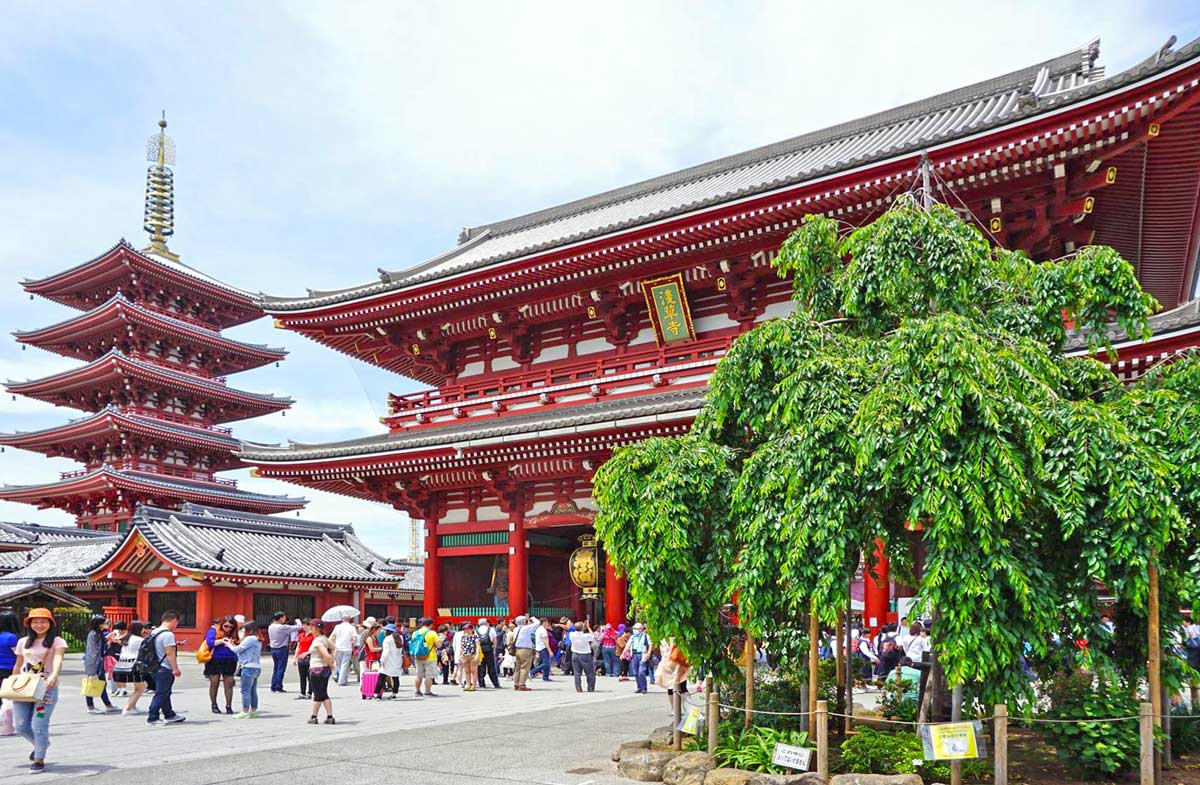
05. Rainbow Bridge
Located in the Minato ward, the Rainbow Bridge connects the man-made island of Odaiba with the rest of Tokyo. It has solar panels that illuminate usually illuminate it in pink, white, and green, but on special occasions, it also gets lit in rainbow colors (hence the name).
You can walk on the bridge to admire the beautiful panorama of Tokyo Bay and if you are really lucky you can even see Fuji-san on a clear day.
07. Tokyo Imperial Palace
Situated in the Chiyoda district on the grounds of the former Edo castle, the Tokyo Imperial Palace is the main residence of Japan’s Emperor.
The complex includes Fukiage Palace, where the living quarters of the Emperor are located, the main palace (Kyūden), as well as various residences of the Imperial Family members.
You can register for a FREE guided tour of the grounds here, or you can try your luck directly at the gate. But do remember that they only allow a fixed number of visitors every day.
06. Meiji Jingu
Meiji Jingu is a beautiful Shinto Shrine in Shibuya ward, Tokyo, devoted to the spirits of Emperor Meiji and his wife, Empress Shōken. It is free to enter the grounds, but there’s a small fee to visit Meiji Jingu Gardens or Meiji Jingu Museum.
Despite being located in the very heart of the city, the shrine impresses the visitor with its tranquility and serene atmosphere.

09. Takeshita Street
Takeshita Street (Takeshita-dori) is a busy pedestrian shopping alley in Harajuku, lined with vintage fashion stores and cosplay shops, as well as many cafes and restaurants.
The narrow street is pretty much the symbol of the quirky Harajuku area and sits at the center of Japan’s teenage culture.
09. Hachiko
Hachiko is a famous statue and popular meeting place outside the busy Shibuya railway station. The bronze statue depicts an Akita Inu dog named Hachiko, who faithfully waited for his deceased owner to return from work, every day for nine whole years until he eventually passed as well.
The story was an inspiration for the movie “Hachi: A Dog’s Tale” with Richard Gere, which I recommend you see. But just a small warning: there will be TEARS!
10. Tokyo Tower
Inspired by the worldwide famous Eiffel Tower, the red and white Tokyo Tower is a broadcasting and observation tower in the Minato ward. A symbol of Japan’s post-war rebirth, it was the tallest structure in the country until the completion of Tokyo Skytree.
The tower has two observation decks from where visitors can admire a great panorama of Tokyo. I recommend you visit near sunset to see the city as it lights up (you can buy your ticket online from here).

Landmarks in Kyoto
11. Kiyomizu-dera
Kiyomizu-dera (also known as the Temple of the Pure Water Spring) is a Buddhist temple in Kyoto, famous for its wooden platform that extends out 13 meters above the hillside.
The platform offers great views of the valley below, particularly during fall when the leaves change colors or spring when the cherry trees are in bloom.
12. Kyoto Tower
Kyoto Tower is a tall observation tower located close to the railway station, from where visitors can admire a 360-degree panorama of Kyoto.
The tower is a rare modern sight in a city that’s otherwise known for its ancient temples and traditional buildings. You can buy tickets from here.
13. Arashiyama Bamboo Forest
Arashiyama Bamboo Forest (also known as Sagano Bamboo Forest) is a popular bamboo groove located on the outskirts of Kyoto. You can explore the paths on your own or you can book a rickshaw tour.
The easiest way to get to Arashiyama is by using the train. If you get the JR Pass, you will be able to use it on this route as well.

13. Fushimi Inari Taisha
Located on Kyoto’s southern edge, Fushimi Inari Taisha is an important Shinto shrine dedicated to Inari, the god of rice. The shrine is most known for its numerous vermilion torii gates that cover several trails going up the sacred Mount Inari.
Out of all the temples that I visited, Fushimi Inari Taisha is hands down my favorite shrine and you can easily spend 2 hours exploring it. So don’t leave it out of your Kyoto itinerary.
14. Ginkaku-ji
Ginkaku-ji (also known as the Silver Pavilion) is a beautiful Zen temple in Kyoto that impresses visitors with its moss and dry sand gardens.
The main hall of the temple was originally intended to be covered by a thin silver foil (hence the name), but this was never accomplished.
15. Kinkaku-ji
Kinkaku-ji (Golden Pavilion) is one of the most famous and iconic temples in Kyoto. Officially named Rokuon-ji, Kinkaku-ji got its nickname from the pure gold foil that covers the first two stories of its main hall, giving it a distinctive look.
While you can’t enter any of the temple’s buildings, you can wander around its garden and admire it from the outside.

16. Yasaka Shrine
Yasaka Shrine (also called Gion Shrine) is a well-known temple in the heart of Kyoto, located somewhat between the Gion and the Higashiyama districts.
If you happen to be in Kyoto during the month of July, don’t miss the chance to witness Yasaka Shrine’s Gion Matsuri, arguably the most famous festival in the entire Japan.
17. Philosopher’s walk
Philosopher’s walk is a narrow pedestrian path along a water irrigation canal, lined with numerous cherry trees. In spring the walk is particularly busy with locals and tourists alike, as people enjoy the beautiful sakura flowers.
It is said that Nishida Kitaro, a well-known Japanese philosopher, used to practice meditation while walking on this path on his way to Kyoto University, hence the name of the pathway.
18. Kyoto Imperial Palace
The Kyoto Imperial Palace used to be the home of the Imperial Family until the 19th century when both the emperor and the capital were moved to Edo (renamed Tokyo).
Previously the palace could only be seen by joining a guided tour that had to be booked well in advance, but this is not the case anymore. However, there are still English tours offered for those who want to learn more about the history of Kyoto’s Imperial Palace.
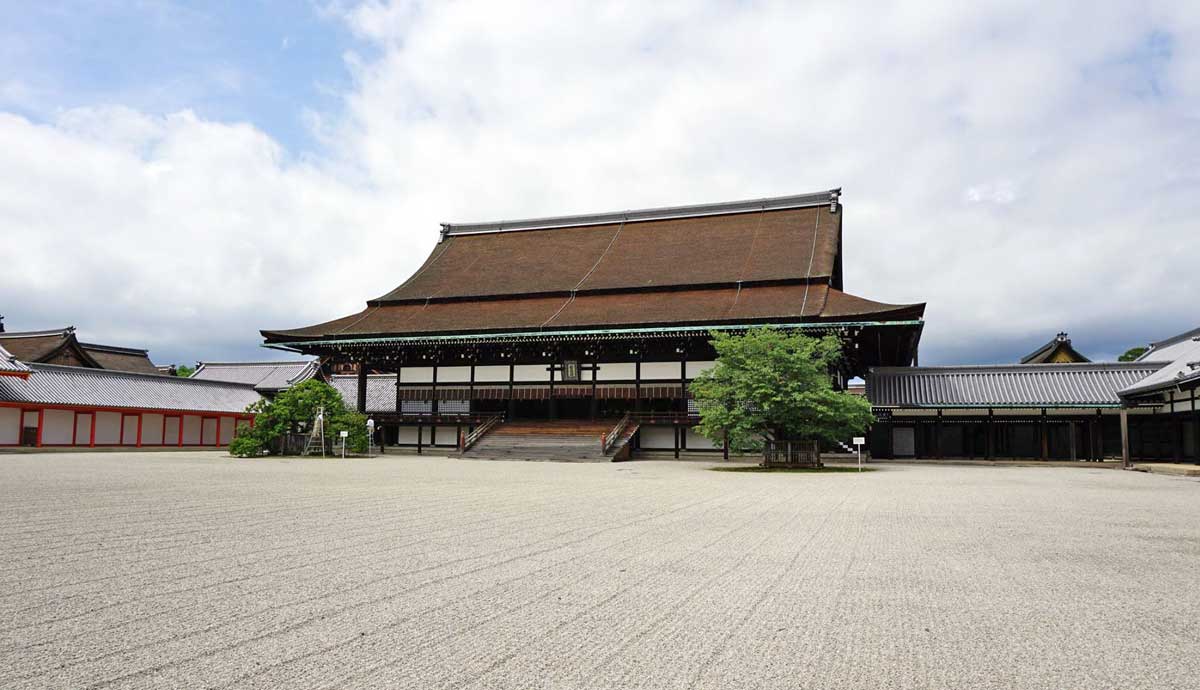
19. Nijō Castle
Nijo Castle was built for Tokugawa Ieyasu (the inspiration behind James Clavell’s Toranaga from the popular book Shogun), to serve as his Kyoto residence. It was later expanded and finished by his grandson, Iemitsu.
Nowadays, the castle (which is now a UNESCO World Heritage site) is open to the public.
20. Heian Shrine
Despite its relatively short history, Heian Jingū is an important Shinto shrine in Kyoto. Due to its many weeping cherry trees, it’s also one of the prime spots to visit during spring to enjoy the famous sakura flowers.
It’s worth mentioning that the main buildings of the shrine are an approximate replica of the Imperial Palace from the Heian Period.
21. Kodai-ji
Kodai-ji is a Zen Buddhist temple established by Toyotomi Hideyoshi’s wife, Nene, to pray for her late husband. The temple is renowned for its beautiful gardens.
In contrast with other famous temples in Kyoto, visitors are allowed to enter the main hall of Kodai-ji (called Hojo).
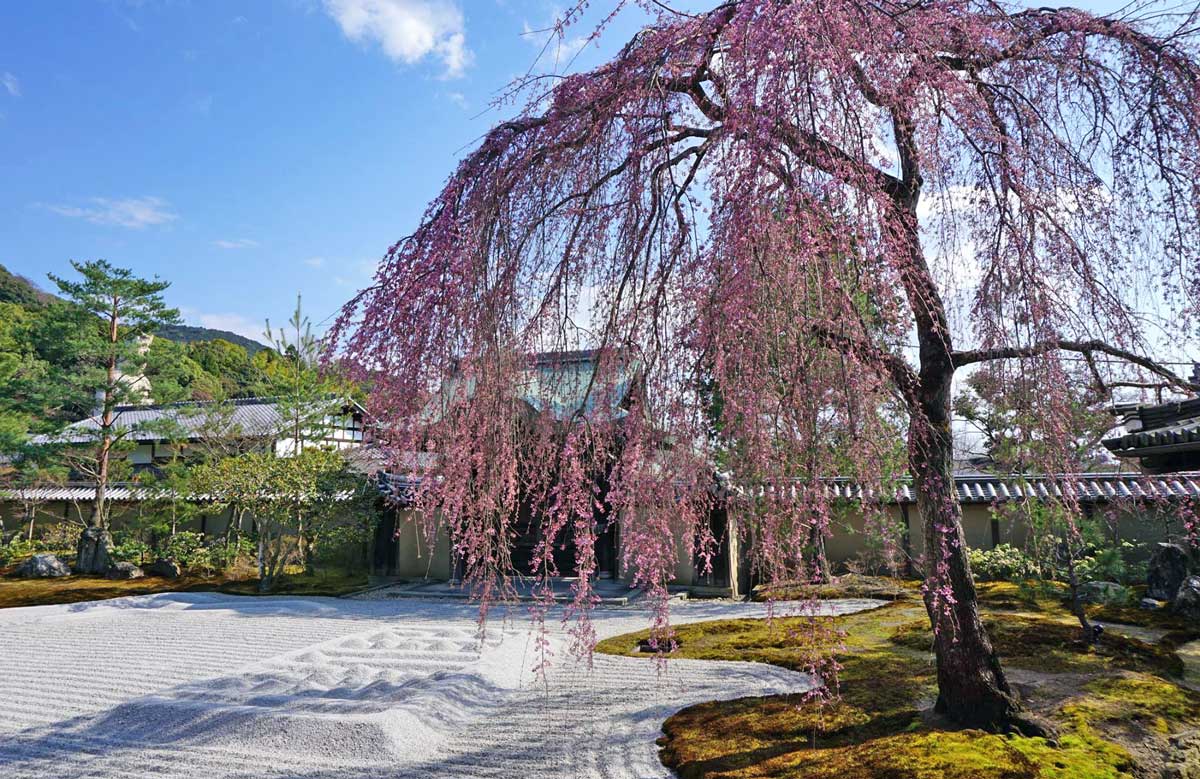
22. Tenryu-ji
Located in Arashiyama, just outside the bamboo groove, Tenryu-ji is the most important temple in the district and a UNESCO World Heritage Site.
Upon entering the grounds, visitors can admire its beautiful garden featuring a large central pond with Koi fish, surrounded by rocks.
23. Tōfuku-ji
Tōfuku-ji is a fairly large Zen temple and one of the best spots in Kyoto to witness the changing of the leaves, during the fall season.
The temple is mostly free to visit, however, two of its areas (Tsutenkyo Bridge and Kaisando Hall) require a ticket.
Landmarks in Nara
24. Nara Deer Park
Nara Park (Nara Kōen) is a large park in the heart of Nara, that hundreds of wild deer have claimed as their home.
Considered to be messengers of the gods in Japanese culture, the deer roam freely through the park and have become an important symbol of the city. Visitors can feed them special crackers (called Shika Senbei) that are sold by locals throughout the park.

25. Daibutsu (Tōdai-ji)
The ancient temple of Todai-ji in Nara is famous for housing the world’s largest bronze statue of Buddha Vairocana (Daibutsu), measuring about 14.8 meters in height.
Furthermore, the wooden hall where the statue is located is also used to hold the record for the largest wooden construction in the world.
26. Hōryū-ji
Located a few kilometers away from central Nara, but easy to reach by either train or bus, Horyu-ji is not only one of Japan’s oldest temples and it’s also credited with having the world’s oldest wooden structures. This includes a 5-story pagoda.
Landmarks in Osaka
27. Osaka Castle
At the time of its construction by Toyotomi Hideyoshi, Osaka Castle (Osaka-jo) was the largest of its kind in the entire Japan. However, less than 20 years later, it was destroyed by Tokugawa Ieyasu’s army as he sought to cement his own clan’s domination over Japan.
A few years later Ieyasu’s son, shogun Tokugawa Hidetada, reconstructed Osaka Castle and despite facing many other devastating events in the years to come, some of the walls built during his time still stand today.
Nowadays, Osaka Castle is one of the most important landmarks in Japan and is visited every year by more than 2.5 million people.
While you can get an individual ticket for the castle, I really recommend buying the Osaka Amazing Pass instead, as it grants you unlimited trips by subway, tram or bus in the city, as well as free entries or discounts to more than 50 attractions, including Osaka Castle and gardens.

28. Umeda Sky Building
Umeda Sky Building is one of Osaka’s most identifiable modern landmarks. Consisting of two 40-story tall towers that connect at the top, the skyscraper also features a rooftop viewing platform called The Floating Garden Observatory.
Two escalators suspended between the towers transport visitors to and from the observatory, which for me was a bit nerve-wrenching since I’m afraid of heights.
In the end, it was totally worth it though, since it ended up being my favorite spot to enjoy Osaka’s panorama. I recommend visiting close to the sunset to watch the city light up.
The Floating Garden Observatory is included in the Osaka Amazing Pass, but you can also buy a ticket from here.
29. Tsutenkaku Tower
Also referred to as the Eiffel Tower of Osaka, though the current structure doesn’t quite resemble it anymore, Tsutenkaku Tower is an iconic landmark of Naniwa-ku ward.
The tower features a 360-degree observatory where a statue of Biriken resides. It is said that anyone who rubs the soles of his feet will have good luck.
While the tower is included in the Osaka Amazing Pass, there’s a separate fee for the Outdoor Observation Platform. Or you can buy an individual ticket from here.
30. Gate Tower Building
The Gate Tower Building is famous for having a highway passing through it as a bridge. Yes, you read that right!
The highway in question is actually the Umeda Exit of the Ikeda Route, belonging to the Hanshin Expressway system and it occupies the 4th, 5th and 6th floors of the building which grants it a tenant status.
This unique situation is the result of years of negotiation with Hanshin Expressway Corporation after the building’s owners refused to sell them the land on which it was built.
TIP: The Gate Tower Building is visible from the Umeda Sky Building observatory, so keep an eye out for it if you visit.

31. Tempozan Ferris Wheel
With a total height of approximately 112 meters (367 ft) and a diameter of 100 meters (330 ft), Tempozan Ferries Wheel dominates the Osaka waterfront and offers a great panorama over the Bay. A ride lasts around 17 minutes and it’s free with the Osaka Amazing Pass.
32. HEP FIVE Ferris Wheel
The unique thing about the bright red HEP FIVE Ferris Wheel is the fact that it’s located on the rooftop of a mall! So, even though it might not be very tall (it has a height of about 75m), it still offers a great panorama of Osaka.
As with Tempozan, HEP FIVE Ferris Wheel is included in the Osaka Amazing Pass.
33. Dotonbori
Dotonbori is Osaka’s most prominent hotspot when it comes to great nightlife and entertainment. The area is famous for its bright neon lights and over-the-top signage.
The Glico signboard is the most iconic out of them all and it depicts a sportsman in front of several Osaka landmarks.
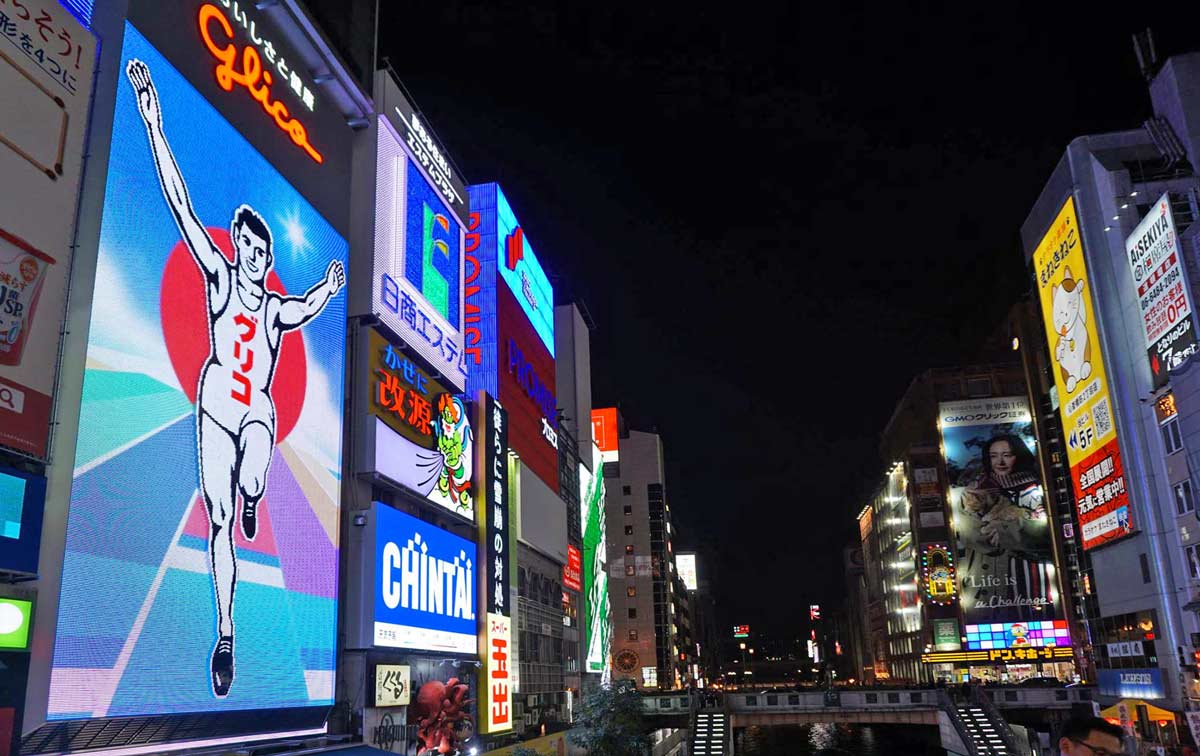
Landmarks in Nikko
34. Toshogu Shrine
Toshogu Shrine is the final resting place of Tokugawa Ieyasu (the founder of the Tokugawa shogunate) and the place where he was enshrined as the deity Tosho Daigongen. As I already mentioned, Tokugawa is the real-life personality that served as inspiration for James Clavell’s Toranaga from the book Shogun.
While initially, it was a fairly simple mausoleum, Toshogu was expanded into the majestic shrine we can see today by Ieyasu’s grandson, Iemitsu.
35. Taiyuin
Taiyuin is the mausoleum of Iemitsu, the 3rd Tokugawa shogun and while it resembles in many aspects with Toshogu it was built purposefully in a more modest manner. This was done to show Iemitsu’s utmost respect for his grandfather.
36. Shinkyo Bridge
Officially belonging to Futarasan Shrine, Shinkyo Bridge is considered one of the three most beautiful bridges in the entire Japan.
Since it’s located right at the entrance of Nikko’s main sightseeing area, it will be really hard to miss seeing it. For a fee, visitors can now stroll across it and back.
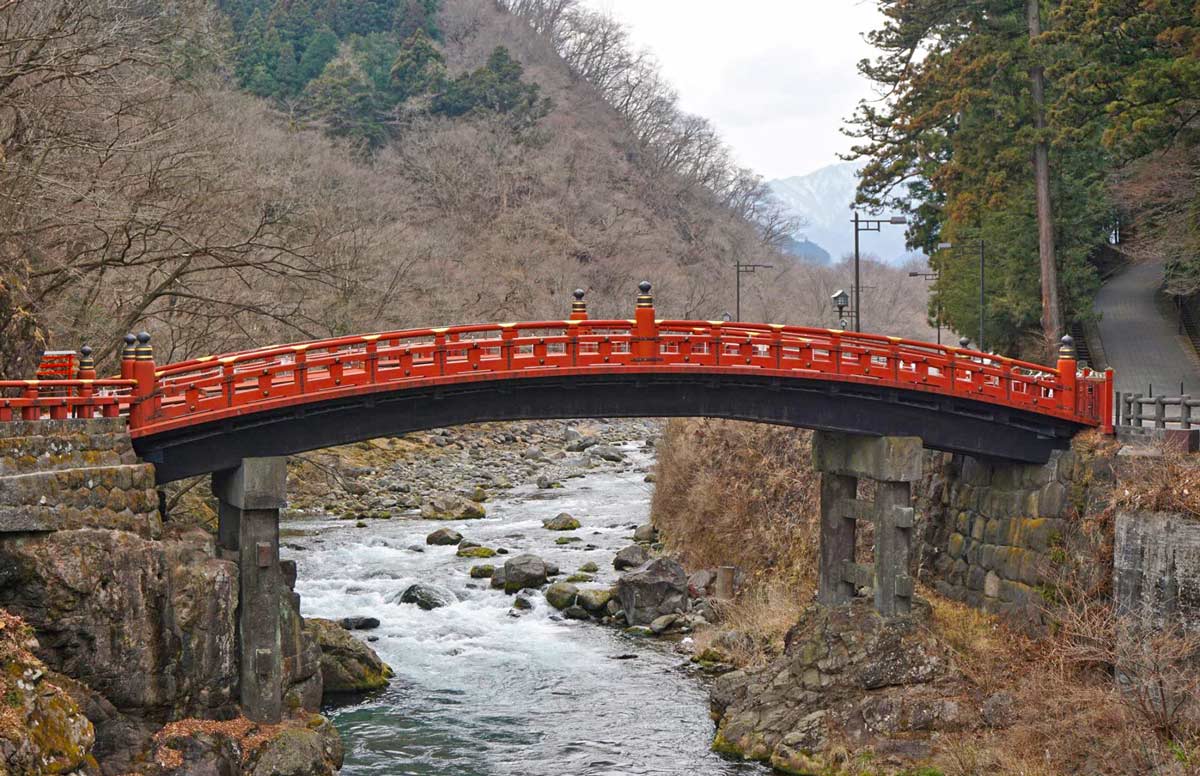
37. Kanmangafuchi Abyss
The Kanmangafuchi Abyss is a short, but beautiful natural gorge along the Daiya River, formed after the eruption of Mount Nantai.
It is most famous for its row of over 70 stone statues of Jizo, a guardian deity of children and travelers. The statues are adorned with red cloth bibs and crocheted caps.
Other must-see Japan landmarks
38. Mount Fuji
Mount Fuji (referred to as Fuji-san in Japan) is an active volcano and the tallest peak (3,776 meters high) in the entire country. A source of inspiration for artists and a pilgrimage site for centuries, Fuji-san is one of Japan’s Three Holy Mountains.
Known for its “shyness” as its incredibly symmetrical snowed cone is often covered by clouds, Fuji is also the most iconic postcard view in Japan. For this reason, day trips to see this amazing volcano (like this one starting from Tokyo) are extremely popular.
39. Genbaku Dome (Atomic Bomb Dome)
Located in the Hiroshima Peace Memorial Park, Genbaku Dome is the only building still standing in the center of Hiroshima after the atomic bomb called Little Boy was dropped on the city during WW2.
This event, along with the Nagasaki bombing marked the end of the war, but the price paid was high: it is estimated that between 100.000 and 200.000 people died immediately or in the aftermath, most of which were civilians.
The building was preserved in the same state as immediately after the explosion and it’s now become a symbol of both hope and destruction, as well as an important reminder that history should not be forgotten or repeated.

40. Himeji Castle
Himeji Castle, also called the White Heron Castle because of its graceful, white architecture, is considered to be the most beautiful castle in the entire Japan. The complex has a rather impressive size and it’s extremely well-preserved.
This is because history was kind to Himeji and it was never destroyed by natural disasters or in battle, thus it’s one of the few original castles that survived the passing of time.
41. Chureito pagoda
If you’ve ever stumbled upon pictures of Japan on the internet, chances are you already seen Chureito pagoda: a 5-story pagoda surrounded by cherry blossoms and overlooking Fuji-san. I don’t think there’s a more iconic scenery than that!
Belonging to the Arakura Sengen Shrine, the Chureito pagoda is a very popular spot with photographers and tourists alike, especially during the Sakura season (for the reason mentioned above). So snap your own postcard view pic by joining a Mt. Fuji tour or by going on your own.
42. Itsukushima Shrine
Itsukushima Shrine is located on a small island near Hiroshima, easily accessible by ferry. The shrine is most famous for its “floating” torii. Make sure you time your visit with the high tide if you want to see the torii surrounded by water.
The island (officially named Itsukushima, but also known as Miyajima) is home to dozens of deer that roam around freely, in a similar manner as in Nara.

43. Kobe Port Tower
The Kobe Port Tower* is the most iconic landmark in the city of Kobe. Made to look like a Japanese drum, the tower dominates the waterfront and offers a 360-degree panorama of the city to its visitors.
TIP: My recommendation for you is to visit Kobe’s Port after dark if you can since that’s when the tower really shines.
44. Nanzo-in
Nanzo-in is a Shingon Buddhist temple in Fukuoka prefecture, most famous for housing the largest bronze statue of a reclining Buddha in the world. The statue weighs around 300 tons and measures 41 meters in length and 11 meters in height.
45. Minato Mirai 21
Minato Mirai 21 is a modern waterfront located in Yokohama and at the same time the most iconic view of the city. The major attractions of the area are:
- Yokohama Landmark Tower, which is the second-tallest building in Japan
- Cosmo World amusement park
- Kishamichi Promenade
- Minato Mirai Hall concert hall
- Pacifico Yokohama convention and exhibition center
- Nippon Maru Museum
- Yokohama Red Brick Warehouse which now acts as a mall and event venue
- Queen’s Square Yokohama shopping complex
- Yokohama Museum of Art
- Yokohama Air Cabin gondola

46. Hakone Shrine
Hakone Shrine is a beautiful shrine on the shores of Lake Ashinoko in Kanagawa prefecture, most famous for its incredibly scenic “floating” torii gate, called the Torii of Peace.
You can admire the vermillion gate in all its beauty as well as Mt. Fuji by doing a lake cruise.
47. Jigokudani Monkey Park
Located in Nagano prefecture, Jigokudani Monkey Park is renowned for its numerous wild Japanese macaques (commonly called snow monkeys) that like to bathe in the warm waters of the area’s hot springs.
48. The Great Buddha of Kamakura
The Great Buddha of Kamakura is a massive outdoor bronze statue of Amitābha, that belongs to the Kōtoku-in Buddist temple. Since the statue is hollow, visitors can actually enter and see its interior.
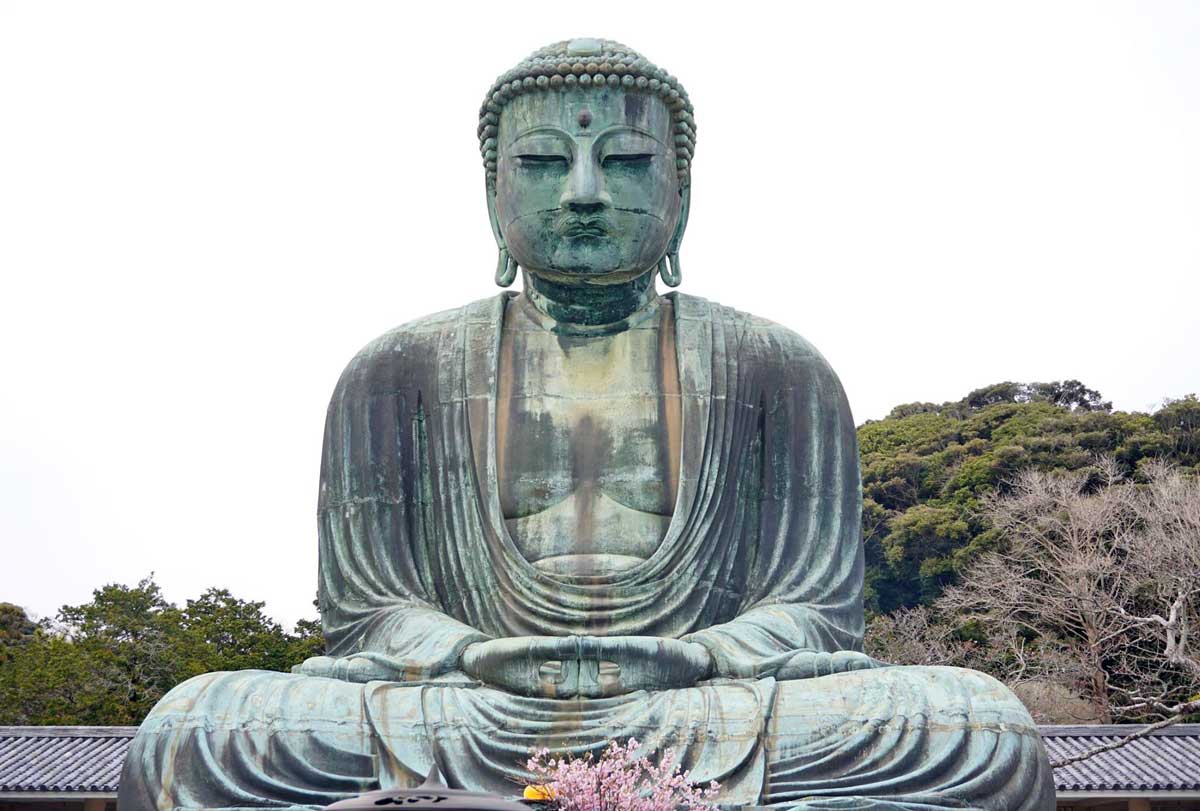
49. Kenroku-en
Kenroku-en (lit. “Garden of the Six Sublimities”) is an exceptionally beautiful Japanese garden, located in Kanazawa. It is regarded as one of the three best-landscaped gardens in the country, along with Kairaku-en and Kōraku-en.
Kenroku-en is open all year round and you can visit it for free if you opt to go during the early visiting hours, otherwise, you need to pay an entrance fee.
50. Kawachi Wisteria Garden
Kawachi Wisteria Garden is a popular tourist attraction in the hills southwest of Kitakyushu city, Fukuoka, most known for its two 100m long tunnels of wisteria.
The garden is open for visits only two times a year: once during the wisteria blooming and once during fall. The admission fee varies depending on when you are visiting. Also, during the peak wisteria season, tickets need to be bought in advance!
Wrap up
From the popular sites of cities like Tokyo or Osaka to world-famous landmarks like Mt. Fuji, Japan is full of wonderful places to visit. And while you could easily spend many months exploring everything the country has to offer, these 50 landmarks are a great place to start.
Happy travels~
YOU MIGHT ALSO LIKE

